In this issue:
- Director’s Corner
- Connecting Nuclear Quark Distributions to Dense Configurations in Nuclei
- Semiconductor Detector Lab Reaches for the Stars
- IDEA-Related Efforts and Resources within NSD
- Fragments
-
Director’s Corner
Fall is kicking off with major developments. The Nuclear Science community is rolling out its new Long Range Plan for Nuclear Science with ambitious scientific and technical goals and clear priorities for the years ahead. Berkeley Lab’s Nuclear Science Division is well aligned with the community’s priorities and will continue to make leading contributions in support of the Long Range Plan and its recommendations.
Additional exciting news comes from CERN, where heavy ion running for LHC Run 3 has commenced and the ALICE experiment is taking data. All detector systems, including the inner tracker system to which LBNL made major contributions, are working as designed and we are looking forward to further revelations on the properties of the quark gluon plasma ahead.
This issue of the NSD newsletter features other exciting examples of NSD science aiming to unravel the nature of the strong force and how technologies pioneered by Berkeley Lab are applied to enable multimessenger astrophysics. In particular, this issue reports on how recent measurements at Jefferson lab are challenging our understanding on how the nuclear interaction between protons and neutrons (nucleons) is modified inside light nuclei. The data seems to indicate that the so-called EMC effect, which measures the modification of the strong interaction inside the nucleus, scales with the overlap between neighboring nucleons. In this issue we also learn about how the LBNL Semiconductor Detector Lab (SDL) is deploying double-sided high-purity germanium (HPGe) strip detectors, a technology pioneered at the SDL, for the next iteration of the NASA Compton Spectrometer and Imager (COSI) mission.
These are just a few examples of the broad spectrum of exciting science and advanced technological developments led by NSD. Some other highlights are featured in the Fragments.
The newsletter also provides a summary of how the Nuclear Science Division continues its strong engagement in outreach and in advancing the IDEA culture within the Division and the broader community. In addition, last month Berkeley Lab’s team, including a sizable contingent from the Nuclear Science Division, was awarded “Absolutely Fabulous Overall Contingent” in the San Francisco Pride Parade. Most recently, the Lab welcomed 200 scouts for the 11th annual Nuclear Science Day for Scouts. It was fantastic to see everyone’s curiosity and fascination with the various facets of nuclear science [photo]. I would like to express my deep appreciation to the many volunteers making this event happen. The badge for this year features the Electron Ion Collider [see photo]. See this Elements article leading up to the event.
Sincerely,
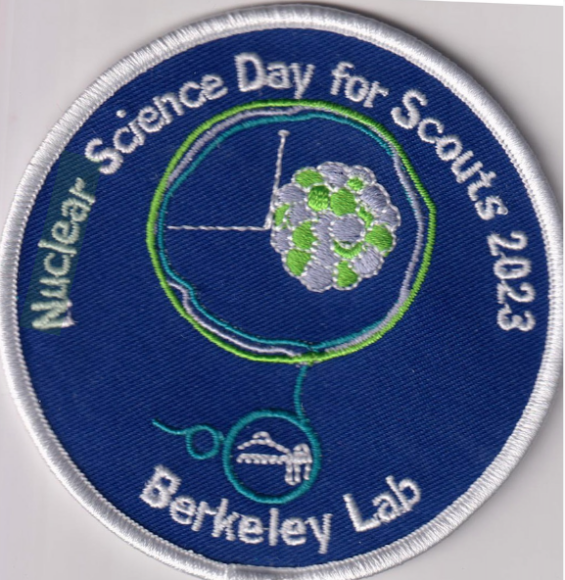
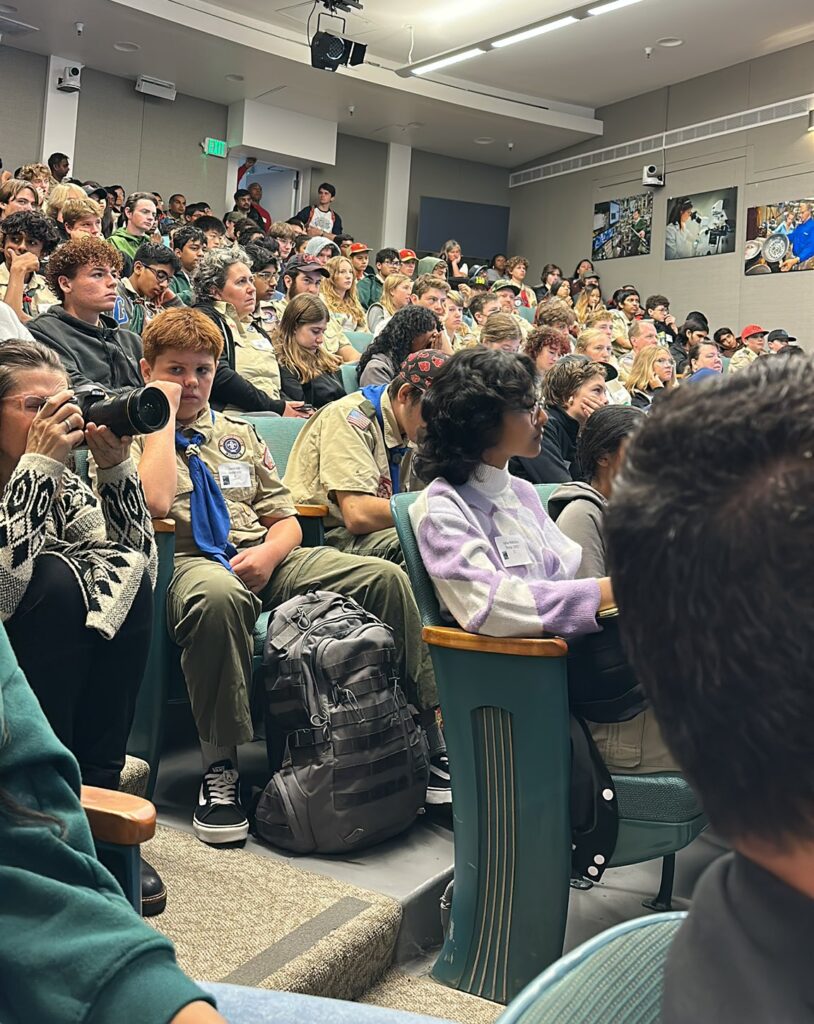

-
Connecting Nuclear Quark Distributions to Dense Configurations in Nuclei
The strong interactions between protons and neutrons (nucleons) in the dense interior of heavy nuclei are believed to be responsible for modifying the internal quark structure of the nucleon. This modification, known as the “EMC effect” [1,2], was observed to scale with nuclear density, yielding a modest A dependence in medium-to-heavy nuclei. Measurements of the EMC effect at Jefferson Lab [2,3] showed that this picture breaks down in light nuclei, with the EMC effect in 9Be, an anomalously low-density nucleus, being much larger than predicted.
As part of the commissioning run in Hall C after the 12 GeV upgrade data were taken on light nuclei including, for the first time, 10B and 11B [5]. These new results confirm the initial conclusion that the EMC effect does not scale with nuclear density. A global analysis of all light nuclei is consistent with the hypothesis that the EMC effect scales with the overlap between neighboring nucleons. This is consistent with the observation of a correlation between the EMC effect and Short-Range Correlations (SRCs), which generate highly-relativistic nucleons in nuclei when these nucleons interact at very short distances. Measurements of SRCs in 10B and 11B were also made, and will allow us to extend the observation of the EMC-SRC correlation to additional light nuclei.
These data were taken as part of a much broader program, initiated by NSD scientist John Arrington, head of the Relativistic Nuclear Collisions Program, and completed earlier this year. The program included two experiments to map out both the EMC effect and the contribution of SRCs across all stable light nuclei [6]. These experiments also included measurements on a variety of heavier nuclei, including 40Ca and 48Ca, to see how these effects change as a function of the neutron excess in nuclei, providing the first opportunity to try and separate density-dependent effects from potential isospin-dependent contributions.
[1] J. Aubert, et al., Phys. Lett. B 123 (1983) 275
[2] J. Gomez, et al., Phys. Rev. D 49 (1994) 4348
[3] J. Seely, et al., Phys. Rev. Lett. 103 (2009) 202301
[4] J. Arrington, et al., Phys. Rev. C 104 (2021) 065203
[5] A. Karki, et al., Phys. Rev. C 108 (2023) 035201
[6] JLab experiments E12-06-105 and E12-10-008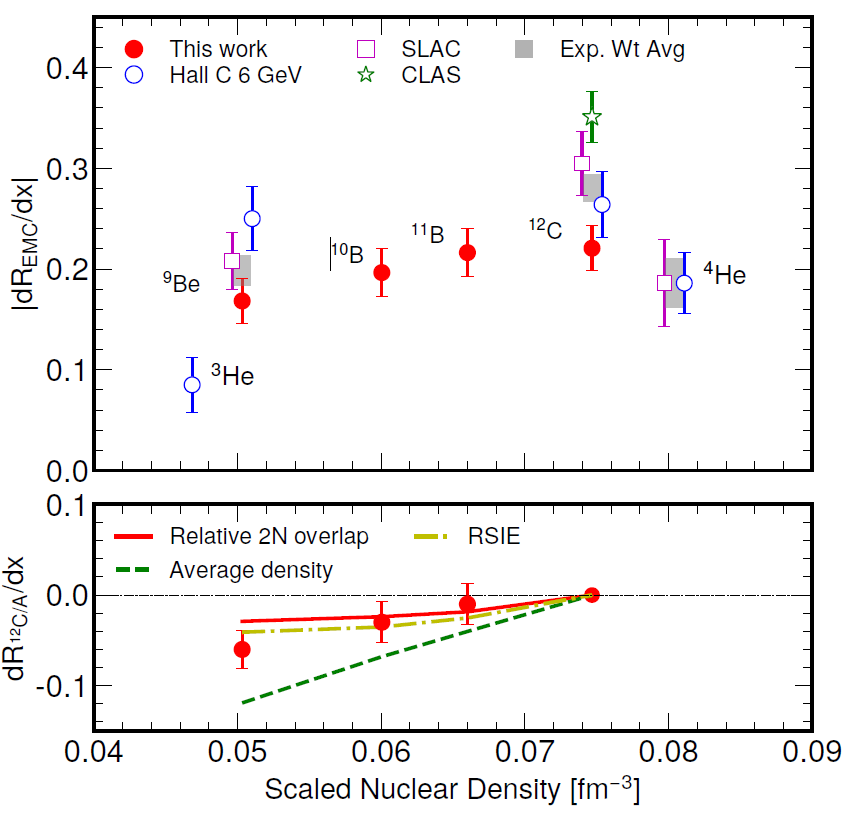
Figure 1: World’s data on the EMC effect in light nuclei including the new measurements (red circles). The data from this result are shown relative to carbon in the bottom panel and compared to curves showing scaling with the average nuclear density and with the relative amount of short-distance NN configurations [3]. -
Semiconductor Detector Lab Reaches for the Stars
For decades, the LBNL Semiconductor Detector Lab (SDL) has been at the forefront of advancements in gamma-ray detector technology. Amongst the technologies pioneered at the SDL are double-sided high-purity germanium (HPGe) strip detectors with amorphous germanium (a-Ge) contacts [1] (Fig. 1). These devices find application in a range of areas including basic science, nuclear security, medical imaging, and gamma-ray astronomy. Using this technology, SDL researchers have designed, developed, and built detectors for multiple instruments for astrophysics projects led by the Space Sciences Laboratory at UC Berkeley [2]. These include the Compton Spectrometer and Imager (COSI) [3-6] and the Gamma-Ray Imager/ Polarimeter for Solar Flares (GRIPS) [7-9], which were successfully flown on balloon missions for NASA.
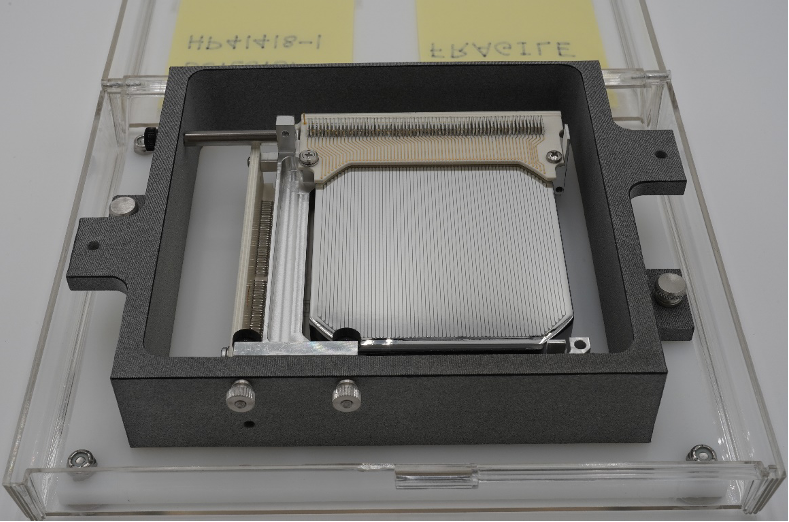
Figure 1: One of the HPGe strip detectors made in the SDL for the COSI instrument prototype. Currently, the SDL is abuzz with activity as researchers work on the next iteration of the COSI instrument [10]. Fig. 2 shows a diagram of this instrument. This gamma-ray telescope is scheduled for launch in 2025 and will be flown on a spacecraft in low Earth orbit for at least two years. An artist’s rendering of the spacecraft is shown in Fig. 3. The primary objective of the COSI instrument is to explore where the production of heavy elements in the Milky Way occurs. It will also map the distribution of positron-electron annihilations, providing valuable insights into the distribution of antimatter. At the heart of this exciting mission to improve our understanding of our galaxy, and at the heart of the instrument, lie SDL detectors.

Figure 2: Rendering of COSI instrument design. The instrument consists of 16 HPGe detectors, each 8 x 8 x 1.5 cm3. Surrounding the detector is a scintillator anti-coincidence shield that is 46 x 46 x 20 cm3. Each detector has a separate power connection and an ASIC for readout. Figure from [11]. NSD’s Joanna Szornel and Mark Amman have recently fabricated the first set of detectors, which are intended for the device prototype. One of these devices is shown in Fig. 1. Soon, they will begin the production of flight detectors for the final instrument.
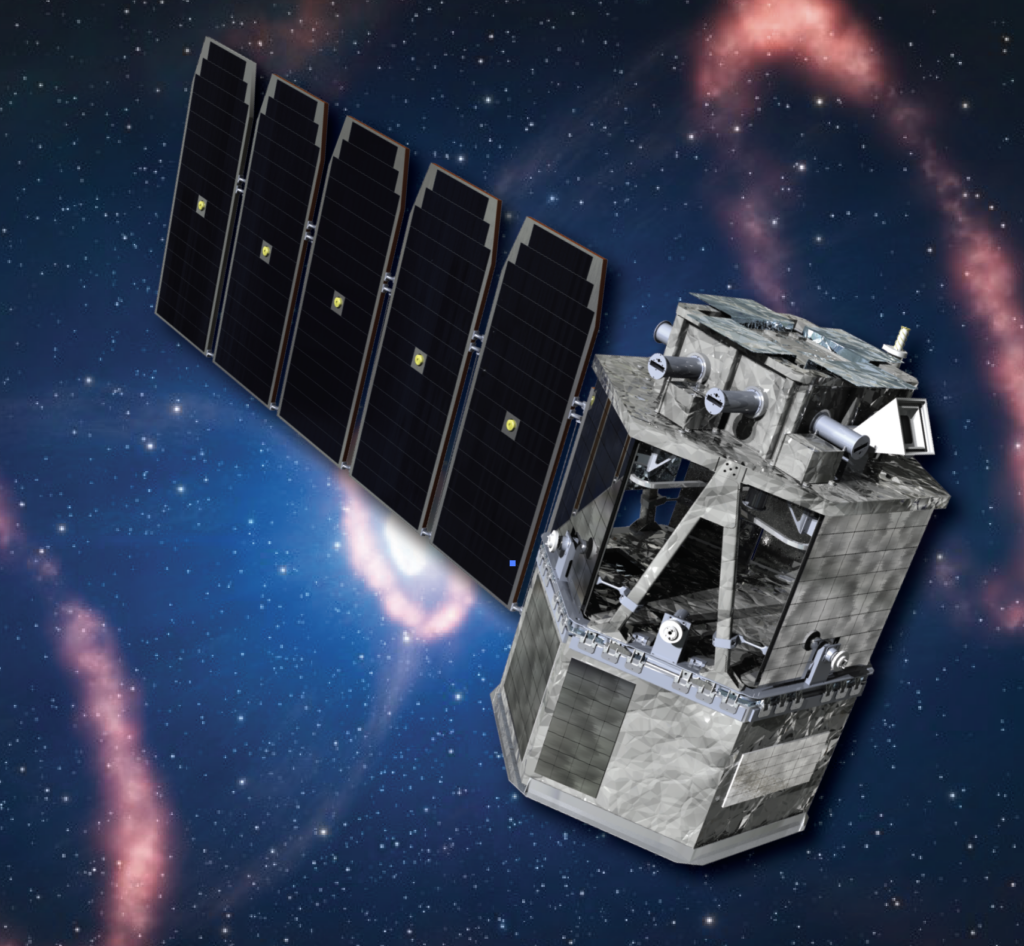
Figure 3: Artist’s rendering of the COSI-SMEX satellite. Image by Jim Willis, courtesy of Northrop Grumman Corporation ½ Space Systems. Background Image courtesy of European Southern Observatory. Overall concept: COSI team. [1] M. Amman et al., Nucl. Instr. Meth. A 579, 886 (2007)
[2] Space Sciences Laboratory
[3] M.S. Bandstra et al., Astrophys. Journal 738, 1 (2011)
[4] A. Lowell et al., SPIE 8443, 84434U-1 (2012)
[5] C.A. Kierans et al., SPIE 9144, 91443M-1 (2014)
[6] A. Lowell et al., SPIE 9915, 99152H-1 (2016)
[7] A. Shih et al., SPIE 8443, 84434H-1 (2012)
[8] N. Duncan et al., SPIE 8862, 88620W-1 (2013)
[9] N. Duncan et al., SPIE 9905, 99052Q-1 (2016)
[10] J.A. Tomsick et al., arXiv 1908.04334 (2019)
[11] https://cosi.ssl.berkeley.edu/instrument/design/ -
Inclusion, Diversity, Equity and Accountability Moments

IDEA-Related Efforts and Resources within NSD
Periodically, it is worthwhile to highlight some of the ongoing efforts within the Nuclear Science Division addressing IDEA topics, and the resources available in NSD and at LBNL more broadly. With each year our staff are engaged more and more in bringing IDEA principles to the forefront of our division culture.
NSD IDEA Council – The NSD IDEA Council is an all volunteer council tasked with engaging the division in IDEA activities aligned with lab-wide efforts, contributing to the growth of IDEA activities and awareness and promoting a fair, safe and inclusive workplace. This is done through the IDEA minute for NSD staff meetings and efforts pushing forward broader and longer-term initiatives. Any NSD staff interested in working with the NSD IDEA Council should reach out to nsd-idea-council@lbl.gov.
Physical Science Workplace Life Committee (PSWLC) – The PSWLC is a committee of representatives from across the Physical Sciences Area at LBNL with support from Human Resources that works to explore and address issues affecting workplace quality of life for the area. This committee addresses challenging topics such as childcare for LBNL employees, work-life balance and promotion guidelines among many others. For more information and to provide input to the PSWLC visit the website.
Luminary Card Program – The Luminary Card Program within NSD is a program for peer-to-peer recognition of actions and efforts in support of fostering an inclusive, diverse and equitable workplace climate. Anyone in NSD can give one (a physical card, or a virtual one!) to a colleague within NSD or elsewhere in the lab or broader research community. For more information and to access a virtual luminary card visit the website.
Under-Represented Minority Targeted Job Posting Boards – Since early 2021 NSD has made available special funding to cover the cost of posting jobs on minority-targeted job posting boards. All hiring managers in the division should talk with their HR recruiter about making use of these funds to advertise position openings in the division.
Outreach and Education – Individual staff in NSD are engaged with LBNL-wide education and outreach programs through the K-12 STEM Education programs and LBNL volunteer portal. In addition to the efforts of individuals, NSD leads events including the Nuclear Science Day for Scouts, which held its 11th annual event on September 30th, with the help of a broad range of staff from all corners of NSD.
Luminary Cards
To recognize their efforts in the area(s) of Inclusion, Diversity, Equity, and Accountability, the following people received a Luminary Card: Tyler Hague
-
Fragments
NSD has received two DOE NP funding awards for two-year projects focussed on artificial intelligence and machine learning. Heather Crawford of the Low Energy Nuclear Physics program will continue to lead a project developing new methods to optimize the performance of the GRETA spectrometer and the VENUS ion source, while Peter Jacobs from the Relativistic Nuclear Collisions program will lead a multi-disciplinary project to develop and deploy novel methods for Bayesian inference and uncertainty quantification. Further details can be found here.
NSD will also collaborate on a newly awarded DOE Nuclear Data project to develop the Berkeley Atlas: a database of absolute cross sections for inelastic, gamma-ray production with 14 MeV neutrons. The project will be led by Johns Hopkins University. The LBNL contribution will be led by Arun Persuad from the Accelerator Technology and Applied Physics Division (ATAP) with Lee Bernstein serving as the NSD lead.
Over the summer, several DOE Highlights featured NSD research, from the final results of the MAJORANA Demonstrator experiment, Lattice QCD results on neutrino-nucleon interaction, and the first observations of the flow patterns of hypernuclei in heavy ion collisions by the STAR collaboration.
In August, NSD Faculty Senior Scientist Barbara Jacak hosted a meeting of the California Electron-Ion Collider consortium. The meeting, which was held on the campus of UC Berkeley, brought together more than fifty physicists from five universities and three national laboratories to coordinate research on physics, calorimetry, and tracking in California.
Also in August, Brian Quiter from NSD’s Applied Nuclear Physics program hosted a workshop on Radiological Data Fusion. The workshop was organized in coordination with DOE NNSA Office of Defence Nonproliferation Research and Development (NA-22) and discussed recent advances and future needs associated with the fusion of radiological and contextual data for nuclear nonproliferation. The workshop was attended by more than forty participants from national laboratories and government agencies.
NSD researcher Bjoern Lehnert has been awarded the 2022 Outstanding Mentor Award by the Berkeley Lab Workforce Development and Education program. Bjoern, who is a Project Scientist in the Neutrinos program, received the award for his mentorship of a student from a minority serving institution through the NSD-led GREAT-NS initiative. Bjoern will formally receive his award at a ceremony on October 3rd.
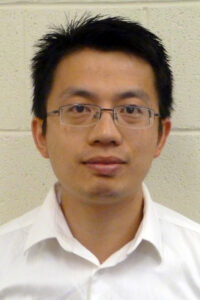
Zhenyu Ye (pictured left) has joined NSD as a Divisional Fellow in the Relativistic Nuclear Collisions program. Zhenyu joins LBNL from The University of Illinois, Chicago and brings a wealth of experience in the development of novel particle tracking detectors.
Shujie Li of the Relativistic Nuclear Collisions program was promoted from Postdoctoral Researcher to Research Scientist.
NSD also welcomes new hires Karthika Balan (Sr. Scientific Engineering Associate), Yuxun Guo (Postdoctoral Researcher), and Thomas MacDonald (Sr. Scientific Engineering Associate). We also welcome Julia Dreyling and Snehadri Das who are interns with the GREAT-NS and SULI programs, respectively.
-
Sign up for our newsletter!